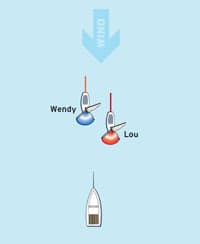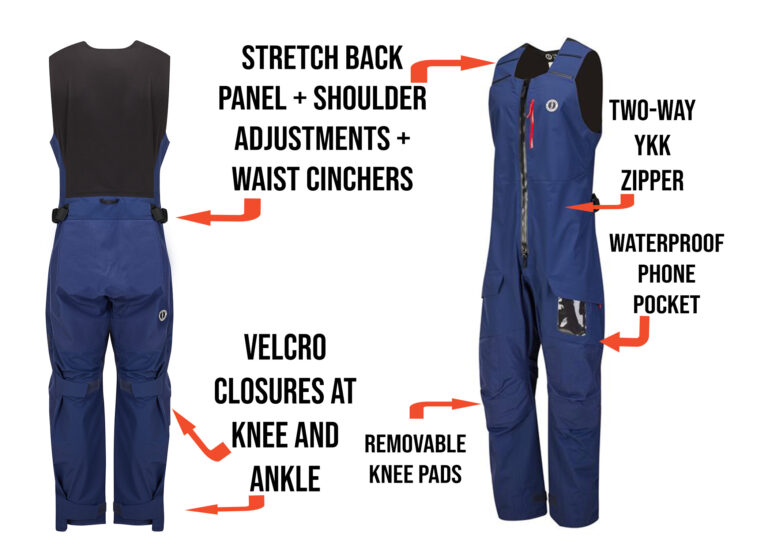
Dave Norton| |Lou can choose to pass the anchored boat on either side, and as the boats pass it the outside boat must give the inside boat room between herself and it.| I am frequently asked how a continuing obstruction differs from a “non-continuing” obstruction. A continuing obstruction is one that takes a considerable amount of time for boats to pass, either because of its size or because of adverse current. It is clear from reading cases and appeals that when boats hug a shoreline in an effort to avoid adverse current, that shoreline is definitely a continuing obstruction. My opinion is that, if it takes you more than about a minute to pass an obstruction, a protest committee will likely consider it a continuing obstruction.
Sometimes, while two fast boats are passing a slower leeward boat on the same tack, it can take them more than a minute to get by her. That leeward boat is an obstruction because both of the boats passing her are windward boats that are required by Rule 11 to keep clear of her. In past years there was debate as to whether or not the leeward boat was a continuing obstruction or merely an obstruction. That debate is now over because this year a new sentence in the definition of obstruction states, “A vessel under way, including a racing boat, is never a continuing obstruction.”

Dave Norton| |Susan can choose to pass the anchored boat on either side, and as the boats pass it the outside boat must give the inside boat room between herself and it. If the boats leave the anchored boat to starboard, Paul may have to bear off to a slower course.|
Old Rule 18 applied at both obstructions and marks and the terms overlap, clear ahead and clear astern did not apply to boats on opposite tacks unless old Rule 18 applied. Now we have new Rule 19 for obstructions and, to make it apply in situations like the one shown in the second diagram, the definition Clear Astern and Clear Ahead; Overlap now states, “These terms . . . do not apply to boats on opposite tacks unless Rule 18 applies or both boats are sailing more than ninety degrees from the true wind.” Therefore, in the second diagram, because Paul and Susan are sailing below a beam reach and neither is clear astern of the other, they are overlapped.
Keep those changes in the definitions in mind while I discuss how new Rule 19 works. Rule 19.1 tells you that the rule applies at obstructions. Some obstructions are also marks that boats must leave on a required side. If a non-continuing obstruction is such a mark, then Rule 18 applies and Rule 19 does not. On some rare occasions a continuing obstruction is a mark. In my experience that only occurs when an island is a mark, as in the Round the Isle of Wight Race in England. In such a case, Rule 19 applies at the island and Rule 18 does not. That is the only time that Rule 18 does not apply at a mark.
At non-continuing obstructions, such as the anchored boat in the first two diagrams, only Rules 19.2(a) and (b) apply, and they are remarkably short and simple. In the first diagram Lou and Wendy are overlapped running on starboard-tack directly towards an obstruction. Suppose Wendy hails for room to leave the obstruction on her starboard side and, at the same time, Lou hails for room to leave it on his port side. Rule 19.2(a) answers the question, “Who gets the room?” Because Lou has right of way as the leeward boat, he may choose which side he wishes to go. If the same question came up in the situation in the second diagram, Susan, who has right of way as the starboard-tack boat, could choose which side she wished to go. If the right-of-way boat chooses to leave the obstruction on her windward side, the other boat is then free to leave it on either side.
If the boats do, in the end, leave the obstruction on the same side, and if they are overlapped while they pass it, then Rule 19.2(b) applies. It requires the outside boat give the inside boat “room between her and the obstruction.” Note that this is a much simpler rule than Rule 18. The boats need not worry about a zone around the obstruction. The inside boat’s right to room is never locked in as the right to mark-room often is at a mark (see Rule 18.2(b)). Rule 19 contains no special exoneration rule like Rule 18.5 in Rule 18 and Rule 20.2 in Rule 20, and it contains no special rules for tacking or jibing near obstructions (like Rules 18.3 and 18.4 for marks).
The inside boat can establish her overlap at any time, even while the boats are passing the obstruction. The only limitation on establishing an overlap is this: the outside boat is not required to give the inside boat room if the outside boat “has been unable to do so from the time the overlap began.”
Remember that when Rule 19.2(b) applies, it never “switches off” any of the rules in Sections A and B. Therefore, in the first diagram if Lou chooses to leave the anchored boat on his starboard side, and if Wendy then passes it on the same side, Rule 19.2(b) requires Lou to give Wendy room between him and the anchored boat, and Rule 11 requires Wendy to keep clear of Lou. If Lou chooses to leave the obstruction on his port side, then Wendy must give Lou room under Rule 19.2(b) and keep clear under Rule 11. This means that Lou may force Wendy as far from the obstruction as he wishes, provided he complies with Rules 16.1 and 17.
In the second diagram, if Susan decides to leave the obstruction to starboard and Paul follows suit, then Susan must give Paul room under Rule 19.2(b) and Paul must keep clear under Rule 10. Note that Paul has an asymmetric chute set and prefers to sail a hot angle to maximize his speed-made-good-to-leeward. However, Rule 19.2(b) does not give him the right to sail at that hot angle while passing between Susan and the obstruction. Susan’s only obligation is to give him space to sail between her and the anchored boat in a seamanlike way. Therefore, he may have to bear off to a slower course while passing the obstruction.
If Susan chooses to leave the obstruction to port, then Paul must give her room to do so under Rule 19.2(b) and must keep clear under Rule 10. Susan must comply with Rule 16.1.

Dave Norton| |Zack should not risk sailing into the gap between Dave and Carla unless he is confident that Carla will be able to give him room.|
The third diagram shows a situation in which Rule 19.2(b) applies at a start. With about a minute to go, a fleet of Lasers is setting up for its start. Everyone has a spot in the front row except Zack, who is hoping he can slip into the front row between Dave and Carla. Here’s how the rules apply to Zack. At the position shown in the diagram, Zack must keep clear of Dave and Carla because he is clear astern of both of them (Rule 12). Carla is required by Rule 11 to keep clear of Dave, which she is clearly doing. Dave is an obstruction to Carla and Zack because both of them are required to keep clear of him. When Zack becomes overlapped to leeward of Carla, several things all happen at that moment. (1) Zack acquires right of way over Carla under Rule 11. (2) Zack must initially give Carla room to fulfill her new obligation to keep clear (Rule 15). (3) Carla becomes obligated to keep clear of Zack (Rule 11), and she must also give Zack room between her and Dave under Rule 19.2(b) unless, despite trying to give room from the time the overlap began, she is unable to do so. (5) Zack must continue to keep clear of Dave, first under Rule 12 and after he overlaps Dave under Rule 11. There is one key factor that makes life rough for Zack. Carla has been moving very slowly with her sails luffing, and she is not required to make any effort to fulfill her obligations under Rules 11, 15, and 19.2(b) until Zack actually gets an overlap on her (see ISAF Case 53). Note that last year, some people thought that Dave was a continuing obstruction, but that it not the case this year, as I explained above.
E-mail for Dick Rose may be sent to rules@sailingworld.com









